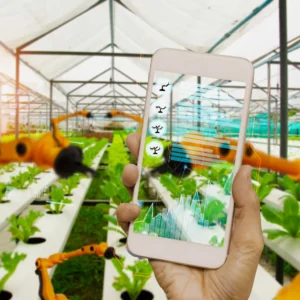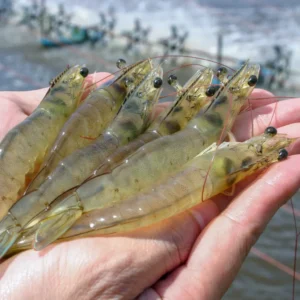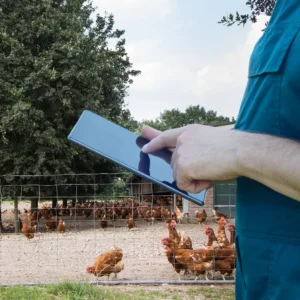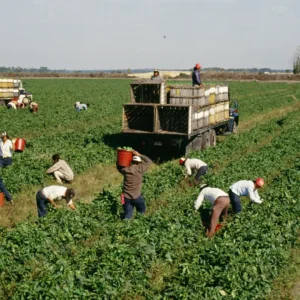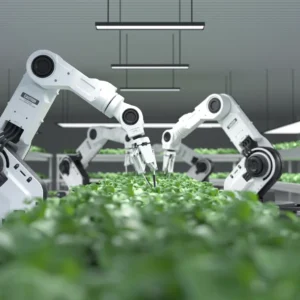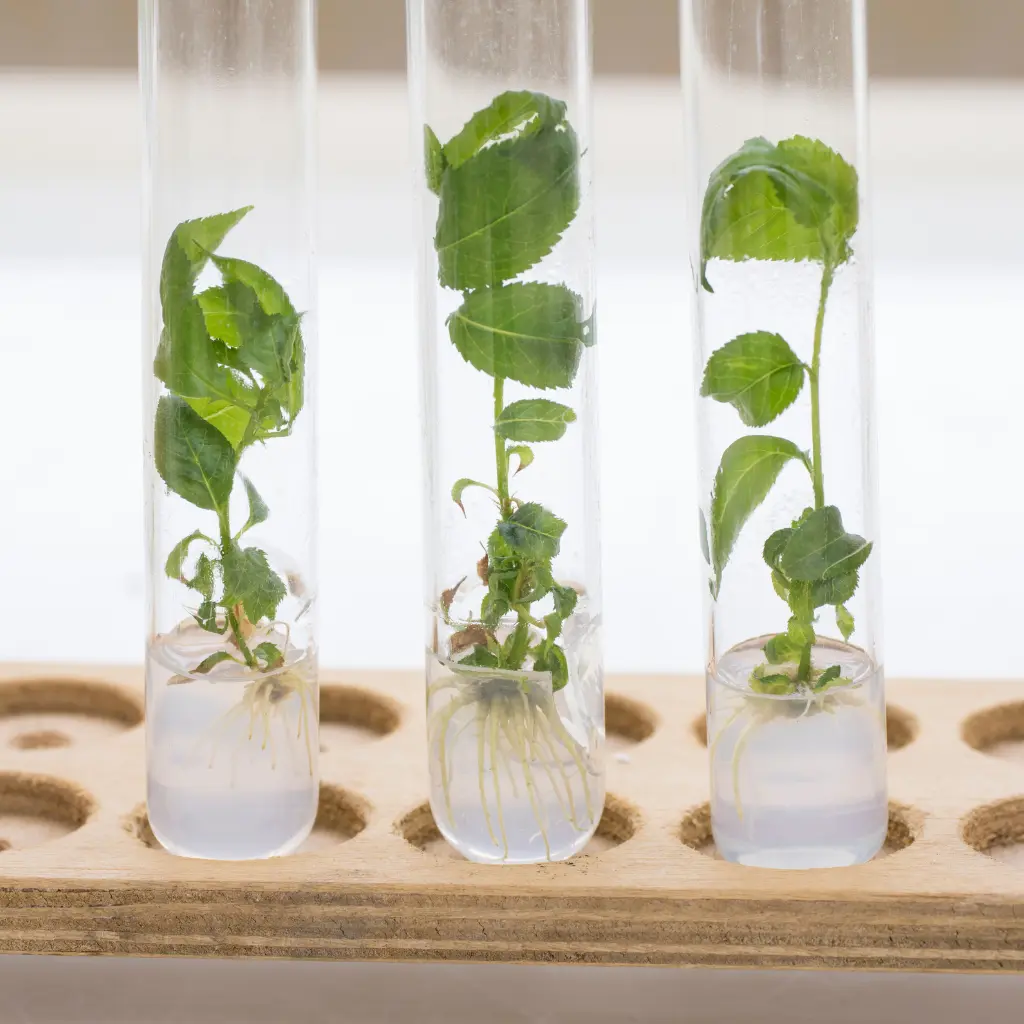
Bespoke Crops
AI in Agricultural Biotechnology
Welcome to the frontier of agricultural innovation, where the synergy of artificial intelligence and biotechnology reshapes how we grow and cultivate crops. In this comprehensive exploration of “AI in Agricultural Biotechnology,” we embark on a thrilling journey through the myriad applications of AI, unlocking the potential to revolutionize farming.
We delve into the intricate world of crop genetics, where AI unravels the secrets encoded in plant DNA, using machine learning for trait prediction and crafting genetically modified organisms (GMOs) with surgical precision. Witness how AI accelerates breeding processes, enhancing disease resistance while optimizing crops for sustainability.
As we traverse this landscape, we discover real-time monitoring, AI chatbots for biotech queries, and the efficiency of streamlined agri-logistics. These innovations ensure that AI extends its transformative influence from the laboratory to the field.
But that’s not all; the future has even more exciting possibilities. Join us as we gaze into the biotech horizon, contemplating how AI will continue to shape agriculture’s future. Explore the revolution and evolution of agriculture through the lens of AI, promising sustainable, efficient, and resilient food production.
Table of Contents
Analyzing Crop Genetics with AI
In AI in Agricultural Biotechnology, the marriage of artificial intelligence and crop genetics yields groundbreaking insights. Using AI in genetic crop analysis, scientists can unlock the secrets encoded in a plant’s DNA with unprecedented precision.
Imagine harnessing the power of machine learning (ML) for trait prediction in crops. AI algorithms sift through mountains of genetic data to identify the genes responsible for drought resistance, pest tolerance, or enhanced yield.
Moreover, AI-driven techniques are supercharging the age-old process of plant breeding. By accelerating breeding processes with AI, we can select and crossbreed plants with desired traits more efficiently, ensuring a brighter future for our food supply.
But it doesn’t stop there. Analytics in crop disease resistance means that AI can help us identify potential threats early, allowing for targeted interventions and reducing the need for harmful pesticides.
And let’s remember the exciting frontier of AI in GMO crop development. Machine learning models can design genetically modified organisms that optimize crop performance, potentially revolutionizing agriculture as we know it.
In this era of biotech innovation, real-time monitoring of biotech experiments keeps researchers on the cutting edge, while AI chatbots for biotech queries empower farmers and scientists alike.
As we delve deeper into the world of AI-enhanced agriculture, we must ask: What’s next? How can we harness predictive analytics to foresee crop adaptation in the face of our changing climate? Please keep reading to find out as we explore the remarkable realm of Predicting Desirable Crop Traits.
Predicting Desirable Crop Traits
Building on the foundation of AI in Agricultural Biotechnology, where we’ve unravelled crop genetics, the next frontier beckons: predicting the traits we desire. Remember how AI analyzed crop genetics? Let’s see how it works its magic in predicting desirable crop traits.
Imagine a future where, with the power of ML for trait prediction, we can forecast which crops will thrive in specific environments, have the highest yield, or possess unparalleled flavour. This isn’t science fiction; it’s the reality AI is creating.
These AI-driven predictions are poised to revolutionize agriculture. Farmers will be armed with the knowledge of which crops to plant, reducing waste and bolstering food security. But how do we get from prediction to production? That’s where the magic happens.
AI-driven plant breeding takes these predictions and fast-tracks the development of new crop varieties. With algorithms steering the selection and crossing of plants, we can bring desired traits to life quicker than ever.
But as we zoom in on the microscopic world of genes, questions arise. How do we ensure these AI-optimized crops are resilient to diseases and pests? That’s where analytics in crop disease resistance comes into play, helping us craft crops that are not only desirable but also robust in the face of challenges.
Now, what’s the key to this accelerated breeding process? Join us as we dive into the fascinating world of Accelerating Breeding Processes with AI, where we’ll uncover the secrets behind turning predictions into reality.
Accelerating Breeding Processes with AI
Having unravelled the potential of AI in Agricultural Biotechnology in predicting desirable crop traits, let’s now bring these predictions to life. How can we swiftly turn forecasts into tangible crops? Enter the realm of accelerating breeding processes with AI.
With the aid of ML for trait prediction, we can precisely select parent plants that carry the desired genetic makeup. AI algorithms analyze vast datasets in a blink, identifying the ideal candidates for crossbreeding. This precision breeding accelerates the development of new crop varieties.
Picture a virtual breeding ground where AI is the matchmaker for plant genetics. It carefully selects the most compatible traits, ensuring the offspring inherit the best qualities. This process, guided by AI, slashes years off traditional breeding timelines.
As we delve into the intricacies of genetic combinations, a crucial question arises: How do we fortify these new breeds against the ever-evolving array of diseases and pests? This is where analytics in crop disease resistance steps in, using data-driven insights to create crops that excel in desired traits and stand resilient against potential threats.
But how do we monitor these experiments in real-time to ensure success? Stay with us as we venture into the world of Keeping Tabs on Biotech Experiments. We’ll unveil how AI provides an unblinking eye on the progress of these revolutionary creations.
Enhancing Disease Resistance via Analytics
We’ve explored how AI in Agricultural Biotechnology accelerates breeding processes, but what about safeguarding our crops against threats? This leads us to the vital role of enhancing disease resistance via analytics.
As we design crops for desired traits, we must ensure they are resilient to diseases and pests. This is where analytics, empowered by AI, shines. By scrutinizing vast datasets, AI identifies patterns and vulnerabilities, proactively enabling scientists to fortify crops.
Imagine a virtual shield powered by data. AI scrutinizes every leaf and stems, looking for signs of trouble. The early warning system allows us to develop plants to fend off threats before they take root.
But the journey doesn’t end there. How do we apply this knowledge to real-world scenarios? How can we translate AI-driven insights into practical solutions? The answer lies in crafting genetically modified organisms (GMOs) with the precision of a surgeon’s scalpel. Join us as we explore the exciting world of crafting GMOs with machine learning, where we shape crops to resist diseases and thrive in challenging environments.
Crafting GMOs with Machine Learning
Building on our quest to fortify crops against diseases and pests, the next frontier in AI in Agricultural Biotechnology leads us to the precision of crafting GMOs with machine learning.
We’ve seen how AI enhances disease resistance through analytics. Now, picture this: AI acts as a virtual genetic engineer, using ML for trait prediction to identify which genes need modification to confer disease resistance or other desired traits.
It’s like painting with pixels but at the genetic level. AI dissects the genome, highlighting the genetic segments to tweak. Scientists can then employ techniques like CRISPR-Cas9 with surgical precision, editing plant DNA to create resilient, high-yielding crops.
But what about ensuring these edited genes are stable and safe for the environment? This is where AI shines again. It can analyze vast data sets to predict potential environmental impacts and guide responsible GMO development.
As we delve deeper into this realm, a critical question arises: How do we monitor and ensure the success of these biotech experiments? Join us in the next segment, where we explore the importance of Keeping Tabs on Biotech Experiments and discover how AI keeps a vigilant eye on the progress of these groundbreaking creations.
Keeping Tabs on Biotech Experiments
Now that we’ve uncovered the art of crafting GMOs with machine learning, the question arises: How do we ensure the success and safety of these groundbreaking creations? Welcome to the world of keeping tabs on biotech experiments with the aid of AI in Agricultural Biotechnology.
Real-time monitoring becomes essential as we modify genes and test new crop varieties. AI, equipped with predictive analytics, acts as a vigilant guardian. It tracks every change and monitors how these experiments perform under various conditions.
Imagine an AI-powered dashboard that provides instant insights into how our engineered crops are faring. It’s like watching every field, greenhouse, and laboratory, ensuring that the fruits of our biotech labour meet our expectations.
But as we navigate this innovative terrain, new challenges emerge. How can we tackle the unforeseen obstacles that might arise during these experiments? How can AI assist in answering biotech challenges and ensure we stay on course to a sustainable, resilient agricultural future? Please stick with us as we explore these fascinating solutions.
Answering Biotech Challenges with AI
In our journey through the realm of AI in Agricultural Biotechnology, we’ve seen how AI monitors and guides biotech experiments. But what happens when unforeseen challenges arise during this groundbreaking journey of discovery? Here’s where the power of answering biotech challenges with AI comes into play.
We may encounter unexpected hurdles as we keep tabs on biotech experiments with AI’s watchful eye. A genetically modified crop may face an unanticipated environmental stressor, or a disease evolves beyond our predictions. With its ability to analyze vast datasets, AI can swiftly identify solutions.
Imagine AI as a dynamic problem-solver, constantly adapting and optimizing strategies in response to emerging challenges. It’s like having a virtual team of experts at your side, brainstorming innovative solutions to ensure the success and safety of biotech experiments.
But as we navigate this complex landscape, a pressing question looms: How can we adapt to challenges and proactively anticipate them? Join us in our next exploration, where we delve into the exciting world of Forecasting Crop Adaptability in Changing Climates with AI and discover how we can future-proof our crops in an ever-evolving world.
Forecasting Crop Adaptability in Changing Climates
As we journey through the realm of AI in Agricultural Biotechnology, we’ve seen how AI tackles challenges. But one of the most pressing challenges of our time is climate change. How can we ensure our crops thrive in shifting weather patterns and unpredictable climates? The answer lies in forecasting crop adaptability in changing environments with AI.
AI becomes our crystal ball in a world where climate uncertainty is the new norm. It uses historical climate data, predictive modelling, and machine learning to foresee how crops perform under various climate scenarios. It’s like having a climate expert to guide our planting decisions.
Imagine knowing which crop varieties will withstand droughts, floods, or temperature extremes. AI’s predictive analytics can provide farmers with invaluable insights, helping them choose crops that thrive even in the most challenging conditions.
But as we harness AI’s power to adapt to a changing climate, we must also consider how to streamline the logistics of agriculture. How can we efficiently bring these resilient crops to market?
Celebrating Streamlined Agri-Logistics
We’ve explored how AI helps us adapt crops to changing climates, but ensuring these resilient crops reach consumers efficiently is equally vital. Welcome to the world of celebrating streamlined agri-logistics powered by AI in the Agricultural Supply Chain.
In our journey to forecast crop adaptability, AI predicts the best crops and optimizes the logistics. Imagine a supply chain guided by AI algorithms, ensuring that suitable crops are grown, harvested, and transported at the correct times. It’s like a symphony where every note, from farm to table, is harmonious.
With AI optimizing the agricultural supply chain, we can reduce food waste, lower costs, and minimize the environmental impact of transportation. This isn’t just about efficiency; it’s about sustainability and feeding a growing world population.
But as we embrace this streamlined future, we must also look forward. What lies ahead in the ever-evolving world of biotech and AI? Join us in our next exploration, where we’ll be gazing into the biotech future with AI, envisioning how these technologies will continue to revolutionize agriculture and shape the world’s food systems.
Gazing into the Biotech Future with AI
As we celebrate the breakthroughs in AI-driven biotech, the natural question arises: What does the future hold for AI in Agricultural Biotechnology? Let’s peer into the crystal ball and explore the fascinating possibilities that lie ahead.
In the coming years, AI-optimized biotech promises even greater precision. Imagine AI algorithms so refined that they can tailor crops for disease resistance and specific soil types, regional climates, and nutritional needs. This level of customization could revolutionize sustainable farming.
The future also holds the promise of AI-powered real-time monitoring on a grand scale. We’re talking about farms with sensors and drones connected to AI hubs that continuously analyze data. Farmers will receive instant insights, enabling them to make proactive decisions and maximize yields sustainably.
But there’s more to the future of AI in biotech. As AI chatbots for biotech queries become increasingly sophisticated, they will serve as accessible resources for farmers worldwide. Imagine instant, AI-driven advice at your fingertips, helping you navigate every aspect of crop management.
And as AI continues to break barriers, we can’t help but wonder: What’s the next frontier? How will AI further transform the agriculture landscape? Join us in the article’s conclusion as we ponder “The Future of Biotech with AI” and embark on a thrilling journey into uncharted territory.
Conclusion
In the world of AI in Agricultural Biotechnology, we’ve embarked on an exhilarating journey through the groundbreaking applications of artificial intelligence, from analyzing crop genetics to gazing into the biotech future.
We’ve seen how AI revolutionizes genetic crop analysis, enabling us to unlock the potential encoded in a plant’s DNA. Machine learning predicts desirable traits, guiding us in creating resilient, high-yielding crops.
AI-driven plant breeding accelerates processes, while analytics enhances disease resistance. We’ve explored the innovative world of GMO crop development, where AI fine-tunes plants for optimal performance.
Real-time monitoring and AI chatbots provide farmers and researchers invaluable support, making biotech accessible and efficient. Predictive analytics ensures crops adapt to changing climates.
As we celebrate breakthroughs in AI-driven biotech, we gaze into the future. AI-optimized biotech promises customized crops for specific needs while real-time monitoring becomes the norm. AI chatbots evolve into trusted companions, and we anticipate the next AI frontier in agriculture.
How will artificial intelligence (AI) continue to impact and transform the agricultural industry in the future? With AI in Agricultural Biotechnology, the possibilities are limitless. As we strive for sustainability and food security, one thing is clear: AI will remain our steadfast ally, driving innovation and transforming the way we nourish the world.
Related Articles
- AI in Smart Agriculture – Precision Farming
- AI in Modern Aquaculture – Underwater Harvest
- AI in Animal Farming – Tech Meets Livestock
- AI in Sustainable Agriculture – Green Gains
- AI in Agricultural Supply Chain – From Farm to Table
- AI in Agri-Finance and Insurance – Safeguarding the Harvest
- AI in Farming Tools and Machinery – Equipped for the Future
- The AI Urban Farming Revolution – Cultivating Cities
- AI in Agricultural Automation – Robotic Revolution
- AI in Post-Harvest Care – Beyond the Harvest
- The Surge of Agri-Tech AI Platforms – Digital Farming
- AI in Combatting Crop Diseases – Healthy Harvests
- AI in Boosting Organic Farming – Natural Nurturing
- AI in Agricultural Supply Chain Management
- AI in Precision Agriculture: Farms for a Sustainable Future
- AI in Crop Forecasting and Analysis: New Agricultural Era
- The Role of AI in Agricultural Robotics: Revolutionizing Farming
- AI in Smart Greenhouses: Revolutionizing Sustainable Agriculture

Arindam Roy
An Automation Consultant with 25+ years of IT Experience
Forbes Articles related to AI usage in the Agriculture Sector:

